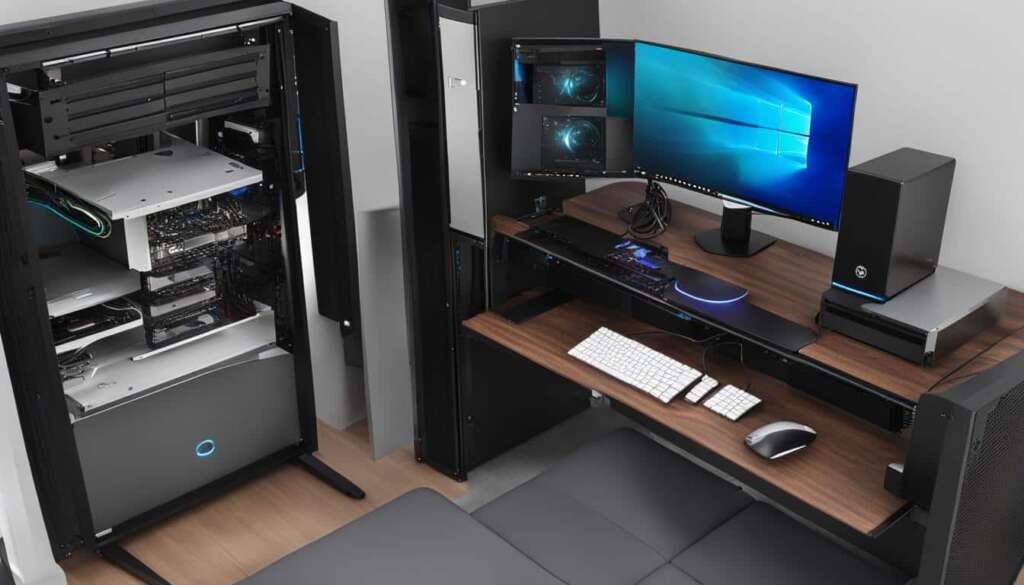Table of Contents
Technology has changed how we work and connect. Now, you can wake up your PC from afar. This is handy for accessing files, running programs, or carrying out tasks. This piece will cover the ways and tools to remotely wake your PC. You’ll get step-by-step guides and useful tips, all backed by research.
Key Takeaways:
- Wake-on-LAN works with modern Ethernet adapters but not so much with wireless ones. It’s best for waking computers over the same network1.
- Turning on Wake-on-LAN needs changes in the computer’s BIOS and the OS settings. This makes remote wake-up smooth1.
- Tools like TeamViewer and WakeMeOnLan make remote wake-up easy on Windows. They come with Wake-on-LAN built-in1.
- Mobile apps like Mocha WOL for iOS and Wake On Lan for Android let you wake your PC from a phone. This boosts convenience and access1.
- Wake-on-WAN is trickier. It involves sending a magic packet to the router’s external IP and arranging port forwarding. Yet, some routers don’t allow port forwarding to the broadcast address1.
If you want easy access to your PC remotely while saving energy, follow our guide. These methods and apps can boost your productivity. They let you make the most of your computer from anywhere.
For detailed steps and more insights, see this guide.
Setting Up Your PC for Remote Wake-Up
Remote wake-up lets you turn on your PC from anywhere. It’s great for convenience and flexibility. To get started, you need to set up your PC right. Here’s how to make sure your PC wakes up smoothly.
Assigning a Static IP Address
Your PC needs a static IP address to receive the wake-up signal. This prevents the IP from changing and missing the signal. Note down your static IP for later use.
Configuring Port Forwarding in Your Router
For remote wake-up, port forwarding is key. You must route Port 9, the Wake-on-LAN port, to your PC’s static IP. This lets the signal reach your PC. Check your router’s guide or online help for setup steps.
Enabling Wake on LAN in your PC’s BIOS
Find the Wake on LAN (WOL) option in your PC’s BIOS. It allows your network adapter to wake your PC with a signal. Restart your computer, press the key for BIOS, and turn on WOL.
Configuring Network Adapter Power Settings in Windows
Along with BIOS, tweak your Windows network adapter power settings. This keeps the adapter ready to receive wake-up signals. In Device Manager, find your adapter. Then, in properties, tick “Allow this device to wake the computer” and “Wake from Shutdown.”
Setting Up an External IP DNS Solution
If you don’t get a static IP from your ISP, use an external IP DNS service. It links a domain name to your changing IP. This way, you can still reach your PC. Pick a DNS service and follow their setup guide.
These steps ready your PC for remote wake-up. Now, you can wake your PC from anywhere. It’s useful for work, access, or personak needs.
Configuring Windows for Wake-on-LAN
After setting up your PC for remote wake-up, you must configure Windows for Wake-on-LAN (WoL). You need to turn on WoL both in the PC’s BIOS and in the OS settings.
To turn on WoL in the BIOS, access the BIOS menu when you start your computer. The steps can differ depending on your computer’s brand. Look for a Wake-on-LAN or WoL option, then switch it on. This will let your computer receive signals over the network to wake up.
In Windows, adjust your network card’s power settings to let it wake the PC. Here’s how:
- Press the Windows key + X and pick “Device Manager” from the list to open it.
- Open the “Network Adapters” category in the Device Manager and find your network adapter.
- Right-click on your network adapter and choose “Properties.”
- Go to the “Power Management” tab in the Properties window.
- Select the “Allow this device to wake the computer” box and hit “OK.”
By selecting this, your network adapter will send wake-up signals to your PC. This allows the use of the WoL feature remotely. Some network adapters might have extra Wo[LLLL] settings, so check all options for the best setup.
To make sure WoL works right, disable fast startup in Windows 8 and later. Fast startup can affect WoL, so turning it off is key. To disable it:
- Press the Windows key + X and choose “Control Panel” from the menu to open it.
- Go to “Power Options” in the Control Panel.
- Select “Choose what the power buttons do” from the menu on the left.
- Click “Change settings that are currently unavailable.”
- In the “Shutdown settings” section, uncheck “Turn on fast startup.”
- Hit “Save changes.”
Turning off fast startup makes sure your PC shuts down fully. This way, it can receive and process WoL signals properly.,p>
Setting up Windows correctly for wake-on-LAN lets you wake your PC from anywhere. This makes accessing your computer easier and more convenient than before.
| Statistic | Value |
|---|---|
| Wake on LAN feature utilization by network administrators | High |
| Wake on LAN enabling remote PC start-up | Yes |
| Article post views | 15,544 |
| Popularity of smart home setups and Wake on LAN | Increasing |
| Configuring Wake on LAN on Windows 10/11 | Access BIOS menu |
| Connecting computer to router for active WoL | Wired Ethernet cable |
Using Wake-on-LAN Apps and Tools
After setting up your PC and Windows for Wake-on-LAN, it’s time to explore the apps and tools available. These let you send a signal to turn on your computer remotely. They make it easy to wake your PC from afar and add more features for handling devices and checking your network.
Remote Access Software with Built-in Wake-on-LAN Capabilities
Top remote access software like TeamViewer and Chrome Remote Desktop include Wake-on-LAN features. This means you can turn on your computer right from their interfaces. It simplifies managing your devices from a distance.
Dedicated Wake-on-LAN Apps
You could also use special Wake-on-LAN apps from your mobile devices. A good example is WakeMeOnLan from NirSoft, which is free. It finds devices on your network with its IP scanner and can send the magic packets for Wake-on-Lan. Mocha WOL is another app that works well. With just a few taps on your phone or tablet, you can easily wake up your PC from anywhere in your network.
Link to source [3]
Make sure the Wake-on-LAN app or tool you pick works well with your PC and network setup. Look at the support for devices, network protocols, and how stable the app is. Checking the app’s documentation or help can guide you to a good choice.
There are other Wake-on-LAN tools too, with special features and functions for different needs. They might offer advanced scanning of networks, managing devices centrally, or setting up automatic tasks.
It’s important to follow good practices for keeping your network and devices secure when using Wake-on-Lan apps or tools. Use proper security measures, encryption, and ways to confirm identities to protect against unauthorised access.
Using Wake-on-LAN apps and tools can greatly help with managing devices remotely. They lessen manual tasks and boost the efficiency of your network. These tools let you turn on your PC from afar, saving time and effort while keeping everything under control.
| App/Tool | Features |
|---|---|
| TeamViewer | Built-in Wake-on-LAN capabilities |
| Chrome Remote Desktop | Built-in Wake-on-LAN capabilities |
| WakeMeOnLan | IP scanner and wake-up functionality |
| Mocha WOL | IP scanner and wake-up functionality |
Table: Wake-on-LAN Apps and Tools
Conclusion
Waking up your PC remotely lets you reach your computer from anywhere. You don’t need to be there to turn it on. This article has shown how to add remote wake-up features to your setup. Remote PC wake-up is great for remote workers, tech fans, or anyone looking to get more done. Technology now makes it simple to wake up your PC from afar and connect to it. Try out these tools and tips now, and make the most of your computer.
The text talked about the Wake on LAN (WoL) method as a key way to switch on PCs from a distance, highlighting its role in managing devices from afar4. It also showed how using small but powerful devices like Raspberry Pi can control things in a smart home4. Ensuring secure connections with SSL certificates was pointed out as critical for keeping data safe4. The article demonstrated using different tools like UDP socket servers for managing PCs remotely4. Showing how WoL, Raspberry Pi, and UDP socket servers work together offered a solid plan for handling devices well4. Lastly, it introduced a way to check on your PC’s status from anywhere, which helps in knowing if it’s available4.
There was also info on statistics stressing why remote access to off PCs matters, with half the article about various ways to do it5. Clear steps for activating Wake-on-LAN were outlined5. It suggested apps like NirSoft’s WakeMeOnLan and AnyViewer for remote desktop access5. Another option shared was Intel Active Management Technology (AMT) for its hardware aspects and setup needs5. For larger settings with many remote PCs, using Dameware by SolarWinds for Intel AMT connections was advised5.
In conclusion, remote PC wake-up gives you ease and flexibility but needs proper setup and security. Using Wake on LAN and Intel AMT allows remote computer access, improving your work. Embrace these techniques and apps to stay linked to your PC from anywhere5. Start using these solutions now and enjoy the perks of waking your PC remotely.
FAQ
What is remote PC wake-up?
Remote PC wake-up lets you power on your computer from afar. You don’t need to press the power button yourself.
Why would I need to wake up my PC remotely?
It’s handy when you’re not near your computer but need to access it. This could be to get important files or do tasks on your PC while away.
How do I assign a static IP address to my computer?
First, go to your computer’s network settings. For Windows, head to the Network and Sharing Center and click on “Change adapter settings.” Right-click your network and choose “Properties.” Then, pick “Internet Protocol Version 4 (TCP/IPv4).” Select “Use the following IP address” and fill in the desired static IP.
What is port forwarding and why do I need to configure it?
Port forwarding directs external internet connections to a specific device on your network. It is essential for sending the wake-up signal to your PC. This usually needs to be set to Port 9.
How do I enable Wake-on-LAN (WOL) in my PC’s BIOS?
To activate Wake-on-LAN, restart your PC and open the BIOS (use F2 or Del). Look under Power Management or Advanced settings for the Wake-on-LAN option. Turn it on, save, and exit.
How do I configure the network adapter’s power settings in Windows?
Right-click the Start button and open “Device Manager.” Find “Network adapters” and right-click yours. Choose “Properties,” then “Power Management.” Ensure “Allow this device to wake the computer” is checked. Click OK.
Can I use Wake-on-LAN with my mobile device?
Yes. Using apps like WakeMeOnLan or Mocha WOL, you can send a wake-up signal to your PC. These are simple to use from your mobile device.
Which apps or tools have built-in Wake-on-LAN capabilities?
Tools like TeamViewer and Chrome Remote Desktop can wake up your computer. This feature is directly available in the remote access software.
Source Links
- https://www.pcmag.com/how-to/turn-on-computer-from-across-the-house-with-wake-on-lan – How to Turn on Your Computer From Across the House With Wake-on-LAN
- https://www.pdq.com/blog/how-to-turn-on-remote-computers-with-wake-on-lan/ – How to turn on remote computers with Wake-on-LAN | PDQ
- https://www.splashtop.com/blog/what-is-wake-on-lan – What is Wake-on-LAN? How to Set Up with Splashtop
- https://thanhtunguet.info/posts/how-i-implement-a-net-core-service-to-wake-my-pc-up-remotely-using-google-actions-and-raspberry-pi/ – Mastering Remote PC Control: A Deep Dive into .NET Core Service Implementation
- https://www.anyviewer.com/how-to/can-you-remotely-access-a-computer-that-is-turned-off-2578.html – Answered: Can You Remotely Access a Computer That Is Turned Off?








